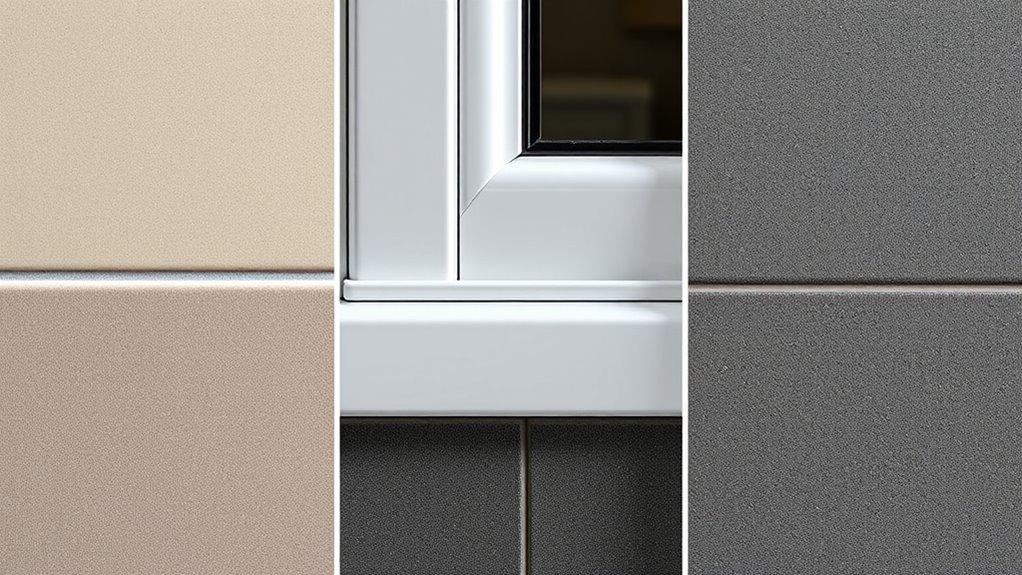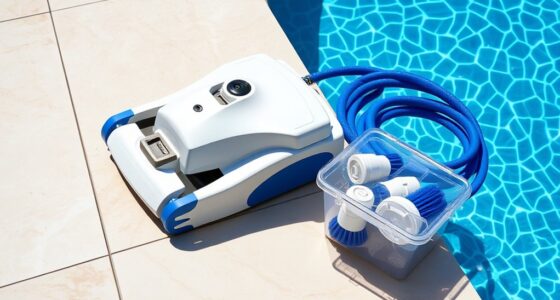Caulk, sealant, and grout each serve different purposes in home improvement. Caulk seals small gaps around windows, doors, and baseboards, offering flexibility and easy application. Sealants are more durable and waterproof, making them ideal for bathrooms and high-moisture areas. Grout fills spaces between tiles, providing support and a finished look but needs replacement over time. Understanding these differences helps you choose the right product; if you keep exploring, you’ll learn even more.
Key Takeaways
- Caulk is flexible and ideal for sealing small gaps and joints that may experience movement.
- Sealants offer superior moisture resistance and are suitable for waterproofing high-humidity areas.
- Grout is used mainly between tiles for stability and aesthetics but is less flexible and more prone to cracking.
- Caulk is easier to apply for quick fixes, while grout requires mixing and cleaning during installation.
- Sealants generally last longer in damp environments, whereas caulk and grout may need replacement sooner.

When choosing the right material for your home improvement project, understanding the differences between caulk, sealant, and grout is essential. These materials each serve specific purposes, and knowing their application differences can help you select the best option for durability and effectiveness. Caulk is typically used for sealing gaps and joints around windows, doors, and baseboards. It adheres well to most surfaces and remains flexible, allowing it to accommodate movement without cracking. Sealants, on the other hand, are often designed for more specialized applications, like waterproofing bathrooms or sealing around sinks. They tend to have higher resistance to moisture and temperature changes, which can influence their material longevity. Grout is primarily used in tile installations, filling the spaces between tiles. It’s a hardened material that provides structural support and a finished look, but it’s less flexible and more prone to cracking if the underlying surface shifts.
Choosing between caulk, sealant, and grout depends on their specific functions and application needs.
Application differences are significant when choosing between these materials. Caulk is easy to apply with a caulking gun, and it smooths out quickly for a seamless finish. Sealants might require specific preparation or curing times, especially if they’re silicone-based or epoxy. Grout’s application involves mixing and spreading it into tile joints, then cleaning excess before it sets. Each material’s ease of application depends on the surface you’re working with and the environment. For example, caulk is ideal for small gaps and areas that experience movement, while grout is better suited for large, stable surfaces like tiled floors or walls.
Material longevity varies across these options. Caulk can last several years, but it may need reapplication over time, especially in areas exposed to sunlight or frequent moisture. Sealants tend to last longer in damp environments because of their superior resistance to water and temperature fluctuations; high-quality sealants can endure 10-20 years with minimal maintenance. Grout, however, generally has a shorter lifespan—it may crack or stain, requiring re-grouting every 5-10 years depending on the quality of the initial installation and exposure to moisture or wear.
Understanding these differences helps you make smarter decisions based on your project’s needs. If you need a flexible, easily applied seal between stubborn gaps, caulk is your go-to. For waterproofing or high-moisture areas, a durable sealant might be best. And if you’re working on tiled surfaces, grout provides stability and a clean aesthetic, but keep in mind its potential need for eventual replacement to maintain a pristine look. Each material’s application differences and longevity should guide your choice to ensure lasting results.
Frequently Asked Questions
Can Caulk Be Used Outdoors?
Yes, you can use caulk outdoors. It offers excellent exterior durability and weather resistance, making it ideal for sealing gaps and cracks exposed to the elements. Choose a high-quality, outdoor-specific caulk designed to withstand sun, rain, and temperature changes. Proper application guarantees your outdoor projects stay protected and sealed effectively, preventing water intrusion and damage over time. Always check the product label to confirm it’s suitable for exterior use.
How Long Does Grout Typically Last?
Imagine you’re renovating your bathroom, and your grout needs replacement after a few years. Typically, grout lasts around 8-15 years, depending on maintenance and usage. To extend its durability, keep it sealed annually and clean spills promptly. Compared to caulk and sealant, grout’s durability varies—regular upkeep minimizes cracks and stains. With proper maintenance tips, you can maximize its lifespan and keep your tile looking fresh longer.
Is Sealant Waterproof for Showers?
Yes, sealant is waterproof for showers, creating effective waterproof barriers that prevent water from seeping behind tiles. It helps keep moisture out, reducing the risk of mold and mildew growth. Applying a high-quality sealant ensures your shower stays dry and protected over time. For best results, reapply sealant periodically, especially in high-moisture areas, to maintain ideal waterproofing and mold prevention.
Can Grout Be Painted Over?
Sure, you can paint over grout—if you’re aiming for a quick fix or a bold experiment. Just remember, grout doesn’t hold paint like a wall does, so you’ll want to choose a color matching paint designed for tile or waterproof surfaces. Keep in mind, mismatched grout color or poor adhesion can turn into a messy project, making your bathroom look more like a DIY disaster than a sleek upgrade.
What Is the Best Application Temperature for Caulk?
You should apply caulk within the recommended application temperature range of 40°F to 80°F (4°C to 27°C). This guarantees ideal adhesion and caulk durability. If you apply caulk outside this temperature range, it may not cure properly, leading to cracks or gaps over time. Always check the manufacturer’s guidelines for specific product details, but staying within this temperature range gives your caulk the best chance to perform effectively.
Conclusion
Choosing between caulk, sealant, and grout is like picking the right tool for a job—you need the right one to get the best results. Caulk works well for flexible joints, sealant for waterproofing, and grout for filling gaps between tiles. Understanding their differences helps you make smarter repairs and improvements around your home. So, pick wisely and keep your space looking fresh and well-maintained, just like a painter finishing a masterpiece.









